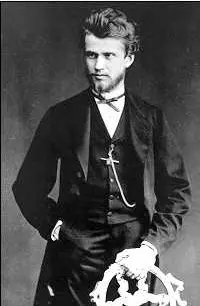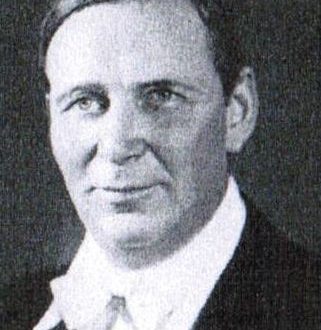
Имре Калман (Imre Kálmán) |
Imre Kálmán
I know that half a page of Liszt’s score will outweigh all my operettas, both already written and future ones… Great composers will always have their admirers and enthusiastic admirers. But along with them, there must be theater composers who do not neglect the light, cheerful, witty, smartly dressed musical comedy, of which Johann Strauss was a classic. I. Kalman
He was born in a resort town located on the shores of Lake Balaton. The very first and indelible musical impressions of little Imre were the piano lessons of his sister Wilma, the violin playing by Professor Lilde, who was vacationing in Siofok, and the operetta “Die Fledermaus” by I. Strauss. A gymnasium and a music school in Budapest, X. Kesler’s composition class at the F. Liszt Academy, and at the same time studying law at the law faculty of the university – these are the main stages in the education of the future composer. He began to compose music already in his student years. These were symphonic works, songs, piano pieces, couplets for cabaret. Kalman also tested himself in the field of music criticism, working for 4 years (1904-08) in the newspaper Peshti Naplo. The composer’s first theatrical work was the operetta Peresleni’s Inheritance (1906). It suffered an unfortunate fate: having seen political sedition in a number of episodes, the government authorities tried to ensure that the performance was quickly removed from the stage. Recognition came to Kalman after the premiere of the operetta Autumn Maneuvers. Staged first in Budapest (1908), then in Vienna, it subsequently went around many stages in Europe, South Africa and America.
The following musical comedies brought worldwide fame to the composer: “Soldier on Vacation” (1910), “Gypsy Premier” (1912), “Queen of Czardas” (1915, better known as “Silva”). Kalman became one of the most popular authors of this genre. Critics noted that his music stands on a solid foundation of folk songs and clearly expresses deep human feelings, his melodies are simple, but at the same time original and poetic, and the finals of operettas are real symphonic pictures in terms of development, first-class technique and brilliant instrumentation.
Kalman’s creativity reached its peak in the 20s. At that time he lived in Vienna, where the premieres of his “La Bayadere” (1921), “Countess Maritza” (1924), “Princess of the Circus” (1926), “Violets of Montmartre” (1930) were held. The melodic generosity of the music of these works created a misleading impression among the listeners of the carelessness and lightness of Kalman’s composer’s pen. And although it was only an illusion, Kalman, who had a wonderful sense of humor, in a letter to his sister advised her not to disappoint those interested in his work and talk about his work like this: “My brother and his librettists meet daily. They drink several liters of black coffee, smoke countless cigarettes and cigarettes, tell jokes… argue, laugh, quarrel, shout… This goes on for many months. And suddenly, one fine day, the operetta is ready.”
In the 30s. the composer works a lot in the genre of film music, writes the historical operetta The Devil’s Rider (1932), its premiere was Kalman’s last in Vienna. The threat of fascism hangs over Europe. In 1938, after the capture of Austria by Nazi Germany, Kalman and his family were forced to emigrate. He spent 2 years in Switzerland, in 1940 he moved to the USA, and after the war, in 1948, he returned to Europe again and lived in Paris.
Kalman, along with I. Strauss and F. Lehar, is a representative of the so-called Viennese operetta. He wrote 20 works in this genre. The enormous popularity of his operettas is due primarily to the merits of the music – brightly melodic, spectacular, brilliantly orchestrated. The composer himself admitted that the music of P. Tchaikovsky and especially the orchestral art of the Russian master had a great influence on his work.
Kalman’s desire, in his words, “to play music in his works from the bottom of his heart” allowed him to extraordinarily expand the lyrical side of the genre and get out of the enchanted circle of operetta clichés for many composers. And although the literary basis of his operettas is not always equivalent to music, the artistic power of the composer’s work surpasses this shortcoming. The best works of Kalman still adorn the repertoire of many musical theaters in the world.
I. Vetlitsyna
Imre Kalman was born on October 24, 1882 in the small Hungarian town of Siofok on the shores of Lake Balaton. His musical talent was versatile. In his youth, he dreamed of a career as a virtuoso pianist, but, like the idol of his youthful years, Robert Schumann, he was forced to give up this dream by “beating” his hand. For several years he seriously thought about the profession of a music critic, being an employee of one of the largest Hungarian newspapers, Pesti Naplo. His first composing experiences were awarded public recognition: in 1904, in a concert of graduates of the Budapest Academy of Music, his diploma work, the symphonic scherzo Saturnalia, was performed, and he was awarded the Budapest City Prize for chamber and vocal works. In 1908, the premiere of his first operetta, Autumn Maneuvers, took place in Budapest, which soon went around the stages of all European capitals and was staged across the ocean (in New York). Since 1909, Kalman’s creative biography has been associated with Vienna for a long time. In 1938 the composer was forced to emigrate. He lived in Zurich, in Paris, since 1940 – in New York. Kalman returned to Europe only in 1951. He died on October 30, 1953 in Paris.
Three periods can be distinguished in the creative evolution of Kalman. The first, covering the years 1908-1915, is characterized by the formation of an independent style. Of the works of these years (“Soldier on Vacation”, “The Little King”, etc.), “Prime Gypsy” (1912) stands out. Both the plot of this “Hungarian” operetta (the conflict between “fathers and children”, a love drama combined with the artist’s creative drama), and his musical decision indicate that the young composer, following in the footsteps of Lehar, does not copy his findings, but creatively develops, building an original version of the genre. In 1913, after writing The Gypsy Premier, he justified his position as follows: “In my new operetta, I tried to deviate somewhat from my favorite dance genre, preferring to play music from the bottom of my heart. In addition, I intend to give a greater role to the choir, which in recent years has been involved only as an auxiliary element and to fill the stage. As a model, I use our operetta classics, in which the choir was not only necessary to sing ha-ha-ha and ah in the finals, but also took a great part in the action. In “Gypsy Premiere” the masterful development of the Hungarian-Gypsy principle also attracted attention. The prominent Austrian musicologist Richard Specht (generally not the biggest fan of the operetta) singles out Kalman in this regard as the “most promising” composer who “stands on the luxurious soil of folk music.”
The second period of Kalman’s work opens in 1915 with the “Queen of Csardas” (“Silva”), and completes it with “Empress Josephine” (1936), staged no longer in Vienna, but outside of Austria, in Zurich. During these years of creative maturity, the composer created his best operettas: La Bayadère (1921), The Countess Maritza (1924), The Circus Princess (1926), The Duchess of Chicago (1928), The Violet of Montmartre (1930) .
Over his last works “Marinka” (1945) and “Lady of Arizona” (completed by the composer’s son and staged after his death) – Kalman works in exile, in the USA. In his creative path, they represent a kind of afterword and do not introduce fundamental changes in the interpretation of the genre that has developed at the central stage of evolution.
Kalman’s musical stage concept is individual. It is characterized, first of all, by such a level of drama and conflict in the development of the main line of action, which the operetta did not know before. The attraction to pointed stage situations is combined with an unprecedented intensity of expression: where Lehar’s lyrics of a romantically colored feeling fascinate, Kalman’s genuine passion vibrates. The intra-genre contrasts are more pronounced in the author of La Bayadère, melodramatic pathos is set off by the brilliance of especially masterfully interpreted comedic interludes. Melos, as rich and varied as Legar’s, is emotionally saturated and imbued with erotica, it uses the rhythms and intonations of jazz more widely.
Kalman’s operatic prototypes of the genre very clearly show through – both in the interpretation of the plots and in the musical style; it is no coincidence that “Silva” is called “an operetta paraphrase of “La Traviata””, and “The Violet of Montmartre” is likened to Puccini’s “La Boheme” (with all the more reason that Murger’s novel served as the plot basis of both works). The operatic nature of Kalman’s thinking is also clearly revealed in the field of composition and dramaturgy. Ensembles, and especially large finals of acts, become for him the pivotal points of form and key moments of action; the role of the choir and orchestra is great in them, they actively develop leitmotifism, and are saturated with symphonic development. The finals coordinate the entire formation of musical dramaturgy and give it a logical focus. Lehar’s operettas do not have such a dramatic integrity, but they show a certain variety of structure options. In Kalman, however, the structure, outlined in the Gypsy Premiere and finally formed in The Queen of Czardas, is reproduced with minimal deviations in all subsequent works. The tendency to unify the structure, of course, creates the danger of the formation of a certain pattern, however, in the best works of the composer, this danger is overcome by a convincing implementation of a tried and tested scheme, the brightness of the musical language, and the relief of images.
N. Degtyareva
- Neo-Viennese operetta →
List of major operettas:
(dates are in parentheses)
“Autumn Maneuvers”, libretto by C. Bakoni (1908) Soldier on Vacation, libretto by C. Bakoni (1910) Gypsy Premier, libretto by J. Wilhelm and F. Grünbaum (1912) The Queen of Czardas (Silva), libretto by L. Stein and B. Jenbach (1915) Dutch Girl, libretto by L. Stein and B. Jenbach (1920) La Bayadère, libretto by J. Brammer and A. Grunwald (1921) “Countess Maritza”, libretto by J. Brammer and A. Grunwald (1924) “Princess of the Circus” (“Mr. X”), libretto by J. Brammer and A. Grunwald (1926) The Duchess from Chicago, libretto by J. Brammer and A. Grunwald (1928) The Violet of Montmartre, libretto by J. Brammer and A. Grunwald (1930) “The Devil’s Rider”, libretto by R. Schanzer and E. Welish (1932) “Empress Josephine”, libretto by P. Kneppler and G. Hercella (1936) Marinka, libretto by K. Farkas and J. Marion (1945) The Arizona Lady, libretto by A. Grunwald and G. Behr (1954, completed by Karl Kalman)





